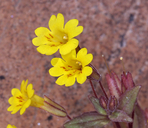Taxon Report
Erythranthe calcicola N.S. Fraga & D.A. Yorklimestone monkeyflower |
 Steve Matson, 2017 |
Taxon Summary
Erythranthe calcicola, commonly known as limestone monkeyflower, is a annual herb in the Phrymaceae that is found in California and elsewhere. It occurs within Joshua tree "woodland", Mojavean desert scrub, and Pinyon and juniper woodland, growing at elevations from 915 to 2165 meters. Erythranthe calcicola is ranked 1B.3, Plants Rare, Threatened or Endangered in California and Elsewhere; Not very threatened in California.Classification
|
Scientific Name: |
Erythranthe calcicola N.S. Fraga & D.A. York |
|
Common Name: |
limestone monkeyflower |
| Family: | Phrymaceae |
| Element Code: | PDPHR01010 |
| USDA Plants Symbol: | |
|
Synonyms/Other Names: |
|
Ecology and Life History
| Lifeform: | annual herb |
| Blooming Period: Apr-Jun | Apr-Jun |
| Elevation: | 915-2165 (3000-7105) |
| General Habitats: | Joshua tree "woodland", Mojavean desert scrub, Pinyon and juniper woodland |
| Microhabitat: | Carbonate (usually), Slopes (usually), Talus (usually) |
| Microhabitat Details: |
Conservation Status
| CA Rare Plant Rank: | 1B.3 |
| Global Rank: | G3 |
|
State Rank: |
S3 |
| State List: | None |
| Fed List: | None |
| Other Status: | BLM_S; SB_CalBG/RSABG |
|
CRPR Changes: |
|
Occurrence Data from the CNDDB
| Total Occurrences: | 15 |
| Element Occurrence Ranks: | |
| Excellent (A) | 0 |
| Good (B) | 0 |
| Fair (C) | 0 |
| Poor (D) | 0 |
| None (X) | 0 |
| Unknown (U) | 15 |
| California Endemic: False | |
| California Counties and Islands: Name (Code) | |
| Inyo (INY), Mono (MNO) | |
| Quads: Name (Quad Code) | |
| Chloride City (3611668), Echo Canyon (3611646), Emigrant Canyon (3611742), Emigrant Pass (3611732), Joshua Flats (3711728), Last Chance Mtn. (3711736), Laws (3711843), Panamint (3611711), Santa Rosa Flat (3611746), Talc City Hills (3611736), Waucoba Canyon (3611788), Waucoba Mtn. (3711811), Waucoba Spring (3711718), Wildrose Peak (3611731) | |
Threat List Data from the CNDDB
| Threat List Total: | 0 | |
| EOs with Threat Listed: | Total EOs | % of EOs |
| 0 | % | |
|
|
||
Selected References
| CRPR List Addition on 2013-06-24 |
Citation
California Native Plant Society, Rare Plant Program. 2025. Rare Plant Inventory (online edition, v9.5.1). Website https://www.rareplants.cnps.org [accessed 29 December 2025].